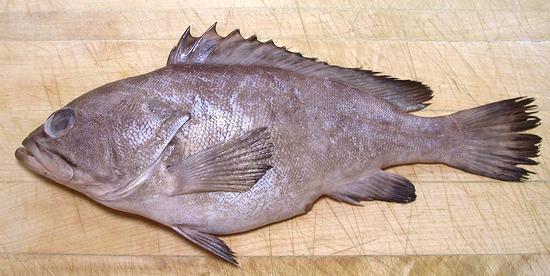 [Lapu-Lapu (Philippine); Epinephelus heniochus]
[Lapu-Lapu (Philippine); Epinephelus heniochus]
This Indo West-Pacific fish is found from the western side of Java to the Philippines and from southern Japan to northern Australia. It can grow to 13-3/4 inches, but the photo specimen was 12-1/8 inches and weighed 14-1/2 ounces. This fish is caught wild, and is ICUN Red List LC (Least Concern).
More on Grouper Family.
Grouper (various species) is highly regarded by restaurant chefs, because the delicate white flesh works well with their sauces. Consequently Groupers are premium priced fish. This grouper's adheres to the pattern, mild, but with enough flavor to be interesting.There is a thin darker center band just under the skin which has a slightly stronger flavor, but it is not offensive. Fillets hold together well enough for poaching if handled gently and they flake apart easily on the plate.
Buying I see this Grouper on ice in Philippine markets, The photo specimen was purchased at a large Philippine market in Los Angeles, (Eagle Rock) for 2019 US $4.99 / pound. Due to poor yield, this is quite an expensive fish, around $15 per edible pound.
Scales: This fish is covered with small but tightly adhering scales that take some energy to scrape off, and they fly about. Some of them will flip over rather than come loose, and you will need to shave those off with the sharp edge of your prep knife.
Cleaning: This isn't the easiest fish to clean as there are a lot of tough membranes inside. The gills pull out very hard, and you may want to cut them loose at the ends with your kitchen shears.
Fillet: This is not a difficult fish to fillet, but dive sharply under the collar because there's quite a bit of flesh there. When you get down to the rib cage it's easiest to cut the ribs from the backbone with kitchen shears and pull them from the fillet. There are some long sharp centerline pin bones for the length of the body cavity you should pull out with your long nose pliers. Pull straight forward as usual. The skirt will have almost no flesh on it, so just cut it off and toss in the stock pot.
Yield: A 14-1/2 ounce fish yielded 4-3/4 ounces of skin-on fillet (33%), or 29% skin off. The yield is not great because of the head is large and long.
Skin: The skin has no strong or "off" flavor, but shrinks a lot when cooked, so must usually be removed. Fortunately it's a relatively easy fish to skin using the usual long knife and cutting board Method, because the raw skin is tough. Cooked, it just about disappears.
Stock: This is an excellent fish for stock. There will still be quite a bit of flesh on the head and the bottom of the collar which is difficult to recover due to the bones. Stock made from the head, fins and bones is mild and quite usable. For details see our Fish Stock page.
sf_gropbrdz 190729 - www.clovegarden.com